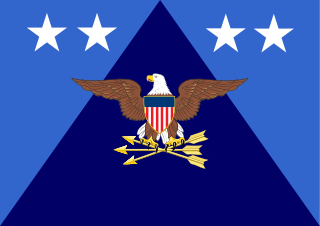Related Research Articles

The Joint Chiefs of Staff (JCS) is the body of the most senior uniformed leaders within the United States Department of Defense, which advises the president of the United States, the secretary of defense, the Homeland Security Council and the National Security Council on military matters. The composition of the Joint Chiefs of Staff is defined by statute and consists of a chairman (CJCS), a vice chairman (VJCS), the chiefs of the Army, Marine Corps, Navy, Air Force, Space Force, and the chief of the National Guard Bureau. Each of the individual service chiefs, outside their JCS obligations, works directly under the secretaries of their respective military departments, e.g. the secretary of the Army, the secretary of the Navy, and the secretary of the Air Force.

The United States Naval Criminal Investigative Service (NCIS) is the primary law enforcement agency of the U.S. Department of the Navy. Its primary function is to investigate criminal activities involving the Navy and Marine Corps, though its broad mandate includes national security, counterintelligence, counterterrorism, cyberwarfare, and the protection of U.S. naval assets worldwide. NCIS is the successor organization to the former Naval Investigative Service (NIS), which was established by the Office of Naval Intelligence after the Second World War.

The Defense Finance and Accounting Service (DFAS) is an agency of the United States Department of Defense (DOD), headquartered in Indianapolis, Indiana. DFAS was established in 1991 under the authority, direction, and control of the Under Secretary of Defense (Comptroller)/Chief Financial Officer to strengthen and reduce costs of financial management and operations within DOD. DFAS is responsible for all payments to servicemembers, employees, vendors, and contractors. It provides business intelligence and finance and accounting information to DOD decisionmakers. DFAS is also responsible for preparing annual financial statements and the consolidation, standardization, and modernization of finance and accounting requirements, functions, processes, operations, and systems for DOD.

Washington Headquarters Services (WHS) is a Department of Defense (DoD) Field Activity, created on October 1, 1977, to provide administrative and management support to multiple DoD components and military departments in the National Capital Region and beyond.
A United States defense standard, often called a military standard, "MIL-STD", "MIL-SPEC", or (informally) "MilSpecs", is used to help achieve standardization objectives by the U.S. Department of Defense.
The Joint Functional Component Command for Intelligence, Surveillance and Reconnaissance was a subordinate command of the United States Strategic Command, one of the nine Unified Combatant Commands under the United States Department of Defense (DOD) and co-located with the Defense Intelligence Agency (DIA). It served as the center for planning, execution and assessment of the United States military's global Intelligence, Surveillance, and Reconnaissance operations from 2005-2016; a key enabler to achieving global situational awareness. In 2016 JFCC-ISR was realigned to the Joint Staff.

The under secretary of defense for personnel and readiness, or USD (P&R) is a high-ranking civilian position in the Office of the Secretary of Defense (OSD) within the United States Department of Defense responsible for advising the secretary and deputy secretary of defense on recruitment, career development, pay and benefits, and oversight of the state of military readiness. The under secretary is appointed from civilian life by the president and confirmed by the Senate to serve at the pleasure of the President.

The United States Department of Defense is an executive branch department of the federal government of the United States charged with coordinating and supervising all agencies and functions of the U.S. government directly related to national security and the United States Armed Forces. As of June 2022, the U.S. Department of Defense is the largest employer in the world, with over 1.34 million active-duty service members, including soldiers, marines, sailors, airmen, and guardians. DoD also maintains over 778,000 National Guard and reservists, and over 747,000 civilians bringing the total to over 2.87 million employees. Headquartered at the Pentagon in Arlington County, Virginia, just outside Washington, D.C., DoD's stated mission is to provide "the military forces needed to deter war and ensure our nation's security".

Project 112 was a biological and chemical weapon experimentation project conducted by the United States Department of Defense from 1962 to 1973.

The Military Health System (MHS) is a form of nationalized health care operated within the United States Department of Defense that provides health care to active duty, Reserve component and retired U.S. Military personnel and their dependents.

Military acquisition or defense acquisition is the "bureaucratic management and procurement process", dealing with a nation's investments in the technologies, programs, and product support necessary to achieve its national security strategy and support its armed forces. Its objective is to acquire products that satisfy specified needs and provide measurable improvement to mission capability at a fair and reasonable price.

The Department of Defense Inspector General is an independent, objective agency that provides oversight related to the programs and operations of the United States Department of Defense (DoD). DoD IG was created in 1982 as an amendment to the Inspector General Act of 1978.

Consolidated and Further Continuing Appropriations Act, 2013 was a bill passed by the United States House of Representatives of the 113th United States Congress. The bill prevented a government shutdown and funded the federal government through September 30, 2013 as it replaced a continuing resolution which expired on March 27, 2013.

The Military Construction and Veterans Affairs, and Related Agencies Appropriations Act, 2014 is an appropriations bill that was introduced into the United States House of Representatives during the 113th United States Congress. The bill would appropriate money to various government agencies related to the United States Department of Defense and the United States Department of Veterans Affairs. This funding would be used during fiscal year 2014, which ends September 30, 2014. According to its committee report, "the purpose of the bill is to support our military and their families and provide the benefits and medical care that our veterans have earned for their service." The report also indicated that the Committee had made its decisions with the national debt and budget deficit in mind.

The National Cybersecurity and Critical Infrastructure Protection Act of 2013 is a bill that would amend the Homeland Security Act of 2002 to require the Secretary of the Department of Homeland Security (DHS) to conduct cybersecurity activities on behalf of the federal government and would codify the role of DHS in preventing and responding to cybersecurity incidents involving the Information Technology (IT) systems of federal civilian agencies and critical infrastructure in the United States.

The Military Construction and Veterans Affairs and Related Agencies Appropriations Act, 2015 is a bill that would make appropriations for fiscal year 2015 for military construction and the United States Department of Veterans Affairs. The bill is considered one of the two easiest appropriations bills to pass each year. The total amount appropriated by the introduced version of the bill is $71.5 billion, approximately $1.8 billion less than fiscal year 2014 due to a decrease in the need for military construction.

The Intelligence Authorization Act for Fiscal Year 2014 is a U.S. public law that authorizes appropriations for fiscal year 2014 for intelligence activities of the U.S. government. The law authorizes there to be funding for intelligence agencies such as the Central Intelligence Agency or the National Security Agency, but a separate appropriations bill would also have to pass in order for those agencies to receive any money.

The Commander of the Office of Special Investigations (OSI/CC) heads the Office of Special Investigations (OSI) and derives its independent criminal investigative authority directly from the Secretary of the Air Force. OSI is also a field operating agency under the administrative guidance and oversight of the Inspector General of the Department of the Air Force.

The Joint Artificial Intelligence Center (JAIC) (pronounced "jake") was an American organization on exploring the usage of Artificial Intelligence (AI) (particularly Edge computing), Network of Networks and AI-enhanced communication for use in actual combat. In February 2022, JAIC was integrated into the Chief Digital and Artificial Intelligence Office (CDAO).
References
- ↑ DoDI 7730.64 (PDF). Department of Defense. 11 December 2004. p. 12. Retrieved 3 August 2023.
- 1 2 Mark Cancian (May 25, 2018), Why Chairman Thornberry failed to tame DOD's fourth estate, breakingdefense.com
![]() This article incorporates public domain material from Fiscal Year 2019 National Defense Authorization Act Chairman's Mark Summary (PDF). House Armed Services Committee . Retrieved 2019-02-22.
This article incorporates public domain material from Fiscal Year 2019 National Defense Authorization Act Chairman's Mark Summary (PDF). House Armed Services Committee . Retrieved 2019-02-22.
![]() This article incorporates public domain material from Human Capital: DOD Needs Better Internal Controls and Visibility over Costs for Implementing Its National Security Personnel System (PDF). Government Accounting Office . Retrieved 2022-03-05.
This article incorporates public domain material from Human Capital: DOD Needs Better Internal Controls and Visibility over Costs for Implementing Its National Security Personnel System (PDF). Government Accounting Office . Retrieved 2022-03-05.